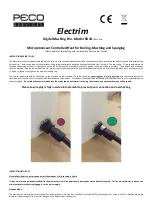
3
and that of your helpers from the arc rays.
Ø
Protect other nearby personnel with suitable, non-flammable screening and/or warn them not to watch the arc
nor expose themselves to the arc rays or to hot spatter or metal.
v
FUMES AND GASES can be dangerous
Ø
Plasma cutting may produce fumes and gases hazardous to health. Avoid breathing
these fumes and gases. When cutting, keep your head out of the fume. Use enough
ventilation and/or exhaust at the arc to keep fumes and gases away from the breathing zone.
In confined spaces or in some circumstances, outdoors, a respirator may be required.
Additional precautions are also required when cutting on galvanized steel.
Ø
Do not cut in locations near chlorinated hydrocarbon vapors coming from degreasing, cleaning or spraying
operations. The heat and rays of the arc can react with solvent vapors to form phosgene, a highly toxic gas,
and other irritating products.
Ø
Read and understand the manufacturer’s instructions for this equipment and the consumables to be used,
including the material safety data sheet (MSDS) and follow your employer’s safety practices. MSDS
forms are available from your welding distributor or from the manufacturer.
v
CUTTING SPARKS can cause fire or explosion
Ø
Remove fire hazards from the cutting area. If this is not possible, cover them to prevent the
welding sparks from starting a fire. Remember that cutting sparks and hot materials from cutting
can easily go through small cracks and openings to adjacent areas. Avoid cutting near hydraulic
lines. Have a fire extinguisher readily available.
Ø
Where compressed gases are to be used at the job site, special precautions should be used to
prevent hazardous situations.
Ø
Do not heat, cut or weld tanks, drums or containers until the proper steps have been taken to insure that
such procedures will not cause flammable or toxic vapors from substances inside. They can cause an
explosion even though they have been “cleaned”.
Ø
Sparks and spatter are thrown from the cutting arc. Wear oil free protective garments such as leather
gloves, heavy shirt, cuff-less trousers, high shoes and a cap over your hair. Wear ear plugs when welding
out of position or in confined places. Always wear safety glasses with side shields when in a plasma
cutting area.
Ø
Connect the work cable to the work as close to the cutting area as practical. Work cables connected to the
building framework or other locations away from the cutting area increase the possibility of the cutting
current passing through lifting chains, crane cables or other alternate circuits. This can create fire hazards
or overheat lifting chains or cables until they fail.
v
CYLINDER may explode if damaged
Ø
Use only compressed gas cylinders containing the correct shielding gas for the process used
and properly operating regulators designed for the gas and pressure used. All hoses, fittings, etc.
should be suitable for the application and maintained in good condition.
Ø
Always keep cylinders in an upright position securely chained to an undercarriage or fixed
support.
Ø
Cylinders should be located:




































